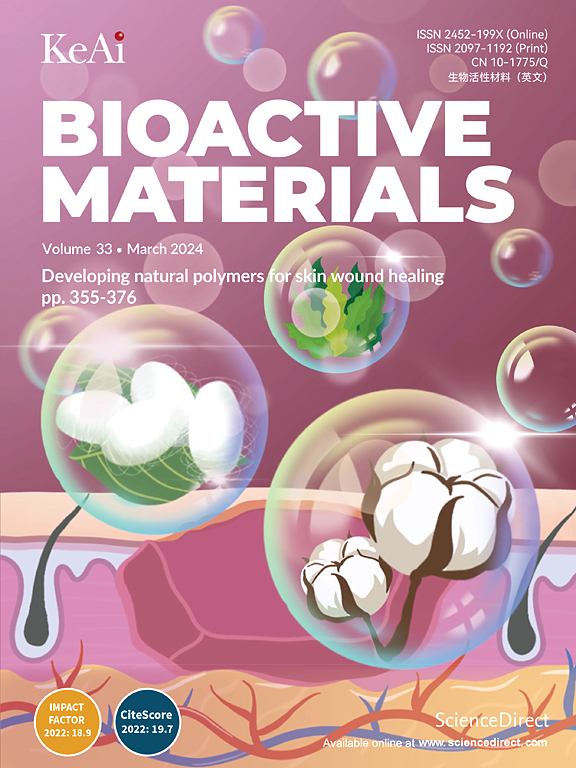A self-accelerating ‘copper bomb’ strategy activated innate and adaptive immune response against triple-negative breast cancer
IF 18
1区 医学
Q1 ENGINEERING, BIOMEDICAL
引用次数: 0
Abstract
Triple-negative breast cancer (TNBC) presents therapeutic challenges due to its aggressive, drug-resistance, and low immunological reactivity. Cuproptosis, an emerging therapeutic modality, is a promising strategic intervention for treating TNBC. Nonetheless, the effectiveness of cuproptosis is compromised by tumor adaptations, including the Warburg effect, increased intracellular glutathione (GSH), and copper efflux, thus breaking the barrier of cuproptosis is the basis for developing cuproptosis-based clinical therapies. Herein, a self-accelerating strategy utilizing a pH-responsive copper framework encapsulating glucose oxidase (GOx), modified with polyethylene glycol (PEG) and tumor-penetrating peptide (tLyp1) has been developed. Upon reaching the acidic tumor microenvironment, the released GOx increases intracellular acidity and hydrogen peroxide (H2O2). The elevated intracellular GSH and H2O2 serve as “fuel” to amplify the copper-based catalytic within tumor cells. Concurrently, the reduction of copper efflux proteins (ATP7B) and the depletion of GSH lead to copper overload in tumor cells, leading to cuproptosis via copper overload, mitochondrial disruption, and Fe-S protein instability. This constellation of interrelated events constitutes a potent “Copper Bomb,” which concurrently triggers the immune system and effectively kills the tumor. It robustly engages innate and adaptive immunity via the release of mitochondrial DNA, facilitating the cGAS-STING pathway and precipitating immunogenic cell death. This process reverses the immunosuppressive tumor microenvironment, eliminates tumor cells, and suppresses metastasis, thus offering a novel therapeutic modality for the comprehensive treatment of triple-negative breast cancer (TNBC).

一种自我加速的“铜弹”策略激活了针对三阴性乳腺癌的先天和适应性免疫反应
三阴性乳腺癌(TNBC)由于其侵袭性,耐药性和低免疫反应性而提出了治疗挑战。铜原位移植术是一种新兴的治疗方式,是治疗TNBC的一种有前景的策略干预措施。尽管如此,铜移的有效性受到肿瘤适应性的影响,包括Warburg效应、细胞内谷胱甘肽(GSH)增加和铜外排,因此打破铜移的屏障是开发基于铜移的临床治疗的基础。本文开发了一种自加速策略,利用ph响应铜框架封装葡萄糖氧化酶(GOx),用聚乙二醇(PEG)和肿瘤穿透肽(tLyp1)修饰。在到达酸性肿瘤微环境后,释放的GOx增加了细胞内酸度和过氧化氢(H2O2)。升高的细胞内GSH和H2O2作为“燃料”在肿瘤细胞内放大铜基催化。同时,铜外排蛋白(ATP7B)的减少和GSH的消耗导致肿瘤细胞中的铜过载,通过铜过载、线粒体破坏和Fe-S蛋白不稳定导致铜退化。这些相互关联的事件构成了一个强大的“铜弹”,它同时触发免疫系统并有效地杀死肿瘤。它通过释放线粒体DNA强有力地参与先天免疫和适应性免疫,促进cGAS-STING通路并加速免疫原性细胞死亡。这一过程逆转了免疫抑制的肿瘤微环境,消除了肿瘤细胞,抑制了转移,从而为三阴性乳腺癌(TNBC)的综合治疗提供了一种新的治疗方式。
本文章由计算机程序翻译,如有差异,请以英文原文为准。
求助全文
约1分钟内获得全文
求助全文
来源期刊

Bioactive Materials
Biochemistry, Genetics and Molecular Biology-Biotechnology
CiteScore
28.00
自引率
6.30%
发文量
436
审稿时长
20 days
期刊介绍:
Bioactive Materials is a peer-reviewed research publication that focuses on advancements in bioactive materials. The journal accepts research papers, reviews, and rapid communications in the field of next-generation biomaterials that interact with cells, tissues, and organs in various living organisms.
The primary goal of Bioactive Materials is to promote the science and engineering of biomaterials that exhibit adaptiveness to the biological environment. These materials are specifically designed to stimulate or direct appropriate cell and tissue responses or regulate interactions with microorganisms.
The journal covers a wide range of bioactive materials, including those that are engineered or designed in terms of their physical form (e.g. particulate, fiber), topology (e.g. porosity, surface roughness), or dimensions (ranging from macro to nano-scales). Contributions are sought from the following categories of bioactive materials:
Bioactive metals and alloys
Bioactive inorganics: ceramics, glasses, and carbon-based materials
Bioactive polymers and gels
Bioactive materials derived from natural sources
Bioactive composites
These materials find applications in human and veterinary medicine, such as implants, tissue engineering scaffolds, cell/drug/gene carriers, as well as imaging and sensing devices.
 求助内容:
求助内容: 应助结果提醒方式:
应助结果提醒方式:


